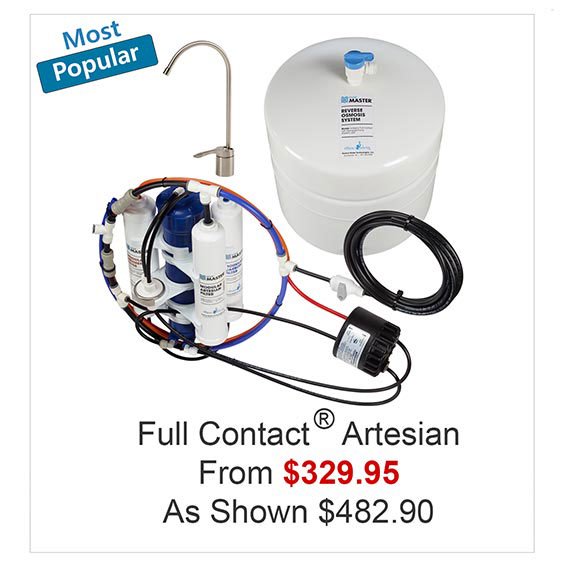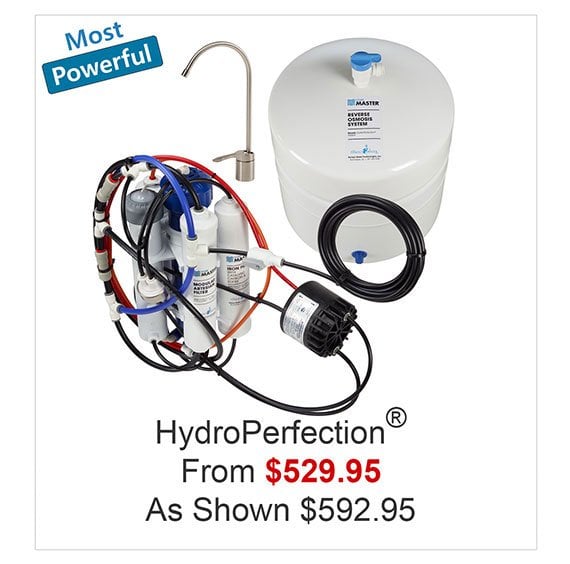All RO systems produce waste water. Period.
Some RO systems claim to be zero waste, but their RO process still produces water waste. However, they satisfy their "zero waste" claim by using an electric pump to do something with that waste water - like circulate it back into the system (which wears down the filter components more quickly), or they push that concentrated water waste into the hot water line (so it ends up in your dishwasher or on your hands when you use the hot water).
We offer a non-electric permeate pump upgrade for our RO systems, which makes the RO system operate more efficiently. This effeciency improvement can reduce water waste by up to 80%, increase water production by up to 50% and produce slightly cleaner water by reducing TDS Creep. There will still be some water waste present while the system is producing clean water, but most of our users achieve a 1:1 waste : pure ratio.
 |
 |
How much water waste is produced?
Simple answer: About 4 gallons wasted per 1 gallon purified (4:1) if you are on a municipal water supply with good pressure, or about 1:1 if you have the permeate pump upgrade.*
Detailed answer: The amount of water waste and clean water produced are intertwined. So before you can understand what is coming out of the system, you'll have to understand what is going into the system. All production and waste water figures are calculated at 77°F, 70psi and 250ppm NaCl input challenge load.
Below 40psi the system will not work and will only produce waste water. So if you are have a private well, check your pump and consider the length and the rise, from the well pump, to the location of the RO system when setting performance expectations and making the decision to add an electric booster pump.
Water temperature will have a similar impact on performance as water pressure. Expect more waste and less production in winter, than in summer.
The challenge load refers the amount and type of contaminants found in the water. The RO membrane is rated at 250ppm NaCl (sodium salt). One simple measure of water composition can be accomplished with a TDS meter. Please note that TDS measurement does not nessisarily equate to water quality, only water composition, since TDS includes minerals as well as salts or metals. Many fine bottled water brands have TDS counts well over 250ppm.
How often is waste water produced?
Simple answer: As soon as you open the RO faucet to get a drink, the system will turn on automatically and will operate for about an hour for each gallon you draw out.*
Detailed answer: Home Master RO systems feature an automatic shut off valve, either as a stand alone component,or incorporated into a permeate pump. It will produce waste water whenever its producing pure water, until the storage tank is full and the RO faucet is closed. Remember that while the RO faucet dispenses the water into your cup relatively quickly, the RO system produces the water to refill the storage tank relatively slowly - about 50 gallons per day, which translates into 1 gallon every 30 minutes.
This number will increase when - you guessed it - the pressure is lower, the water is colder, and the TDS is higher. Also remember that as your pre-filters get plugged up, it too will reduce the pressure to the membrane which increases water waste and reduces water production.
A properly functioning system will not RUN ALL THE TIME. It can, however, run for a couple of hours if you draw out a gallon of water, when your pre-filters are clogged, the water is cold, and you have hard water. Please see the troubleshooting guide in your owner's manual page 8-10, for more troubleshooting steps.
*Typical results. Your results may vary.
Home Master RO Systems Save Time, Money & Water!
..



